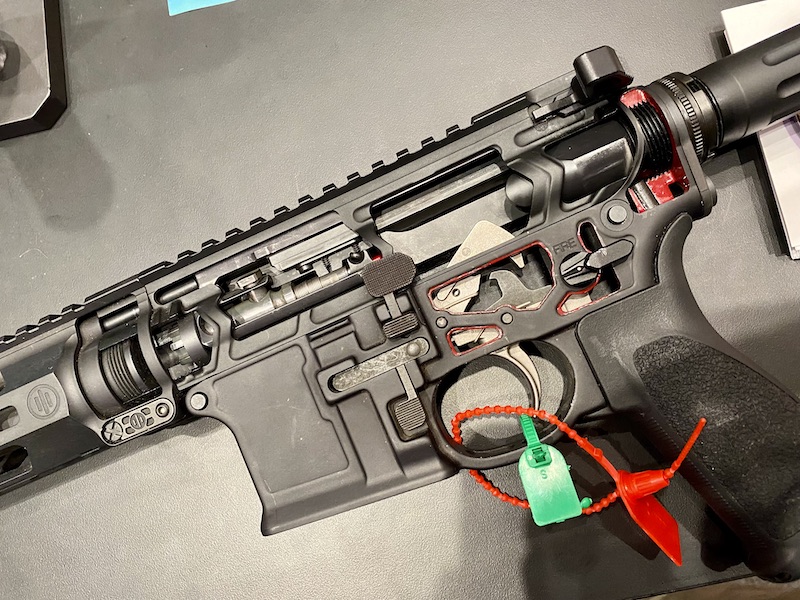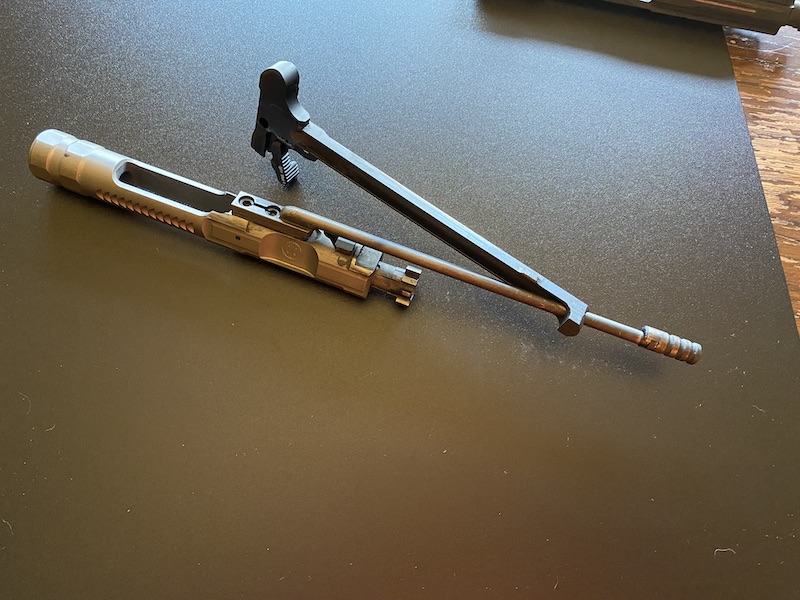Automatic actions on rifles and shotguns have historically separated themselves into two main categories—those that siphon off gas to drive the action and those that use the recoil to keep things moving. Today, we’re taking a look at gas-operated actions as they relate to rifles like the AR-15 and the AK-47: direct impingement and piston-driven.
Direct impingement (DI) is one of those daunting phrases that is harder to spell than it is to understand. 99% of the AR-15s ever built siphon off gas from a tiny hole in the barrel and redirect it down a narrow tube back into the upper receiver, where that gas hits the bolt carrier group and drives it backward. As the BCG travels rearward, the recoil spring is compressed, the spent brass cartridge is ejected, and the next round rises toward the action.

Then, the energy from the gas is spent. Much of that gas vents out of the ejection port with the spent brass. The compressed spring now releases its energy, throwing the bolt carrier back into battery, and (when everything works as planned) a new round is slammed into the breach.
All of this seems oddly primitive. Gas coming back at you? Gas venting from the ejection port, right in front of the shooter’s face?
Why do we put up with it?
Mainly because it works and is relatively easy to build and maintain. While I’m not a gunsmith—not by a long shot—I am an armorer. I’ve built many AR-15s. The modular parts go together, most of the time, like Legos, and if you have the right parts in the right place, there’s a bare minimum of hand fitting needed.
In fact, you can mix and match, swap out parts, and change material—so long as the pieces fit together, running changes rarely impair reliability. That’s not true for an old-school 1911. Though that gun is arguably much simpler, there’s some filing and honing required to get parts working smoothly, and hand-fitting these parts is a kind of wizardry that built legendary gunsmith personalities. For the AR-15, this is generally not the case.

What’s Wrong with Direct Impingement?
DI guns are dirty. The AR is a space-race-era gun made from alloys that were literally cutting edge, but the crap that blows back into an AR’s upper receiver means these guns need regular cleaning. It isn’t hard, but it should be a ritual performed regularly.
Sticky bolts and failures to extract are serious issues. One of the more annoying features of the old design is blow-back—something all too familiar to those making efforts to suppress the AR-15 platform. When you put a silencer on the end, the gas pressure inside the barrel increases, and more gas can run backward in the system.
This over-pressure can ram the BCG back too fast and increase wear on parts. It can screw with the gun’s timing. Worse, though, is the gas and soot that blows out into the face of the shooter. It can be painful at times and is almost always distracting.
If there are other issues, the big one is a slow but progressive degradation of the gas tube. These are narrow, really hard to clean, and—without proper maintenance—will corrode. Eventually. Many of us have AR-15s in regular service, though, that don’t ever develop problems, but it is possible.

The Piston AR
To solve the problem of direct impingement, some enterprising AR builders have taken a page from Kalasnikov’s book and built pistons into the system. This is a great solution, really, as the piston stands as a barrier between the oncoming gas and the upper receiver’s vital moving parts. The gas still exits the barrel through a tiny port, but instead of running down a longer straw—all the way back to the BCG, the gas is funneled into a sleeve that holds the piston rod. This rod is then driven into the upper receiver, actuating the action sequence.

Piston actions are super clean (at least at the receiver side). It also keeps the heat build-up down. There are no extra gasses flowing back into or out of the receiver. Piston AR’s are somewhat magical to those who run suppressed. That’s where the first benefits are most clearly noticeable.
I’ve got hands-on experience with three piston AR makers. My first was an LWRC sent to me for review. As much as I liked its performance, the gun felt precious, and I babied it. Review guns can be like that, especially the expensive ones that are on short-term loans.
The LWRC was slick and smelled good. My next, and one that will never leave, is a PWS. Primary Weapons Systems makes exceptional rifles. This one came in as a pistol, back in the heyday of the pistol-brace era. I liked the way it ran so much that I took it through the SBR process. Since then, I’ve put hundreds of mags through this gun without so much as a hiccup.

And if I’m honest, I’ll cop to the fact that I don’t clean it as often as I should. The PWS has required maybe 1/10th the regular maintenance. I’ve used this as a host platform for numerous optic reviews, mag reviews, and with suppressors from Silencer Central and SilencerCo.

Which is Better: Direct Impingement or Piston?
Piston. I’m going to always go piston. Unless you are looking at this from a cost perspective, or from an ease of build perspective. If you want to build the system from the ground up, DI wins.
I look at this as a sliding scale. This is the AR-15 timeline I see most frequently in my friends.
- Buy an entry-level AR-15 around the $500 price point.
- Shoot it—300 rounds +/-.
- Begin replacing furniture.
- Pick up some new sights, or a red dot, or an optic.
- Decide you would rather build a rifle from parts to suit your needs.
- Hide purchase prices from your significant other for a year or so.
- Get the new gun on the range.
- Discover the beauty of guns in $1,500—3,000 price range.
- Start selling off old projects to ease into the expense.
It is usually around step 5 that I see people replacing entire DI uppers with piston uppers, and around step 9 that I see people justifying a shiny new piece of perfection.
Is a piston-driven AR-15 necessary? Nope. The target down range doesn’t care if that 55-grain bullet left the barrel of a DI gun or a piston gun.


